1999 to 2002 - Nintendo Gamecube action/adventure game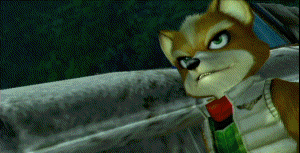 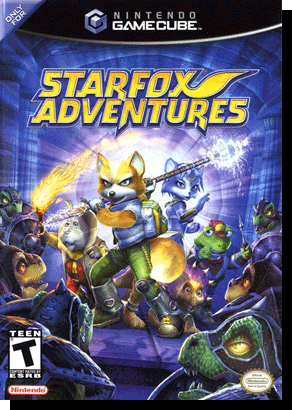 Working for Rare in England - Position: Senior Animator Working for Rare in England - Position: Senior Animator
Although I did a number of tasks over the years on this one, I was predominantly responsible for the real-time cut-scenes. There are about two to three hours of the stuff in this game! I spent an awful amount of time with the characters of this world, bringing them to life. I didn't really have much of a clue what to do with them when I started, but one of the things I remember doing was imaging the lead (later to become Fox McCloud) as Harrison Ford from Indiana Jones. I needed this to gauge what he was thinking at any particular time. I wanted to know how he would react to everything that was thrown at him, whether that was a 200 tone monster or a brattish kid who doesn't know when to shut up. This was a long time in development, beating my years in University and my next longest project "Two Face Tabby" into a cocked hat. And in all that time I had the opportunity to work with a staggering number of character types and throw them into so many situations, it was like a trail by fire for my skills as a film maker. Last time I checked there were over 1,830,000 copies of Starfox Adventures out there.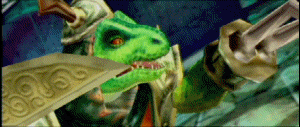 On this page there are links to 25 minutes worth of the sequence work I did on Starfox Adventures. It may seem like a lot but there is actually about 3 hours of cut-scenes in the final game, although it's not that easy to time it since some of those are interactive branching scenes and many will obviously only be seen depending on your performance and choices in the game. Be warned, there are plot spoilers in here. |
The Face Fox meets Tricky - The mischievous side kick makes his first appearance. Read on for an explanation of my work with facial animation and lip-sync... Fox meets Tricky - The mischievous side kick makes his first appearance. Read on for an explanation of my work with facial animation and lip-sync...
Dialogue
This is just one of many hours of scenes containing facial expressions and lip-sync. When you're doing that much footage you tend to develop a system. I've forgotten the subtleties of mine but I guess I started out by laying out the dialogue on the time line. I made sure that I gave natural sounding gaps between the lines while keeping it as tight as I could since I didn't want to bore the viewer with anymore screen time than was absolutely necessary.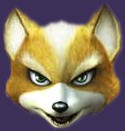 Blocking in
Usually I'd have a loose plan of action for the action of the scene within the environment and start blocking it out with character positions and camera framing. I'll jump ahead a little here so that I can focus on the facial work, so with all the animations in place and queued up against the dialogue it's time to hit the lip-sync key... Ok so it wasn’t that easy, but there was a process that I'm not at liberty to discuss here. However this process only roughed in something that made it easier to make a start. Simplify the curves
I went through the animation curves it generated and started ripping out all the detail. Your mouth moves in a way that smoothes out the motion of what you would expect to get from all the changes in our language. So you don't have to open and close your mouth for every single sound, it just depends on what comes before and after the sound. Frequently you will be able to make the sound with only a deviation in the mouth’s shape on its way to a more extreme shape. So you only really have to accentuate all the most obvious sounds and the rest can be suggested with subtler actions or, occasionally, nothing at all. Mouth shapes
I worked with mouth shapes that needed moving around to sync up with the sound. Each shape would have an in point that would start it blending, and an out point at which the shape would have fully formed. Obviously it took a lot of tweaking to make it really work, but you'd be surprised at how much you could get away with, then just modify the disaster areas (after all, who really knows what a fox looks like when they talk).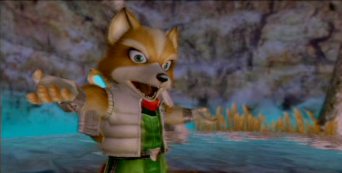 Eyes
Next: the eyes. I simply shifted them around, remembering to... wow, I almost forgot. You have to move the head. I could move the head on top of the library animations and when I added the eye movement it really began to sell the fact that these were living beings. I made the eyes look ahead of the head movement and then correct themselves to centre onto the target that I wanted them to look at in most cases. Most of the time your eyes will move very quickly (2 frames can be enough), so don’t let them linger or you won’t sell the effect. Leaving the eyes in the centre (not focused on anything) can be one of the worst things you can do, it gives the character a vacant or surprised look which is uncommon in real life when you are talking, so be careful not to over use it. Of course sometimes you want to make the character seem inwardly focused so that's a good time to let the eyes wonder slowly without fixing on anything in the environment, leaving large amounts of white around the eyes on all sides. Moving the eyes all the way over to the side, top or bottom will give the character a much more believable look if you actually want them to look at something. But remember that people rarely fix their eyes on someone they are talking to and keep looking without looking away, so the odd flit to one side will make it much more believable. Expressions
Then I just started dropping in the facial blend shapes. They worked in pretty much the same way as the mouth shapes. The key to making expressions work is that it's actually the moment during which they change that makes the action work, not the pose itself. Without movement there aren't many shapes that don't look like they could just be the character's default expression. So I made the shapes change when I needed to highlight a piece of dialogue or show a reaction and I paid close attention to how long each shape took to blend (it was impossible to stop them from reaching 100%, I didn't have that much control). This part of the face works very closely with the movement of the eyes so I made sure that I complemented their position. You can make the same expression have a completely different meaning when it’s accompanied with eyes in a different position, the same goes for the heads angle (forward, back, tilted etc…). Blinks
Finally I'd add the blinks, usually on key reactions or pieces of dialogue to highlight something that was being said. There was rarely the opportunity to drop them in randomly because there was always plenty of more meaningful places to put them. Face Summary
So that’s how I made over three hours of lip-synced facial performances. Of course it only scratches the surface really and in all honesty I actually generated over ten times that much over the course of the project. As things changed so did the dialogue and so did the performance. You could say I got plenty of practice! |
 Meet Drakor - My favourite Boss in the game. Although it may seem contrived I'm going to use this sequence to highlight some principles about animating flight. It isn't the cleanest example of these rules because the thermals rising from the lava affected things (and I cheated for dramatic reasons anyway), but it's still a respectable example. Meet Drakor - My favourite Boss in the game. Although it may seem contrived I'm going to use this sequence to highlight some principles about animating flight. It isn't the cleanest example of these rules because the thermals rising from the lava affected things (and I cheated for dramatic reasons anyway), but it's still a respectable example.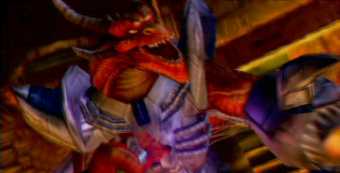
Up and down
This is unbelievably obvious, but a winged creature will bob up and down when it flaps it's wings (you wouldn't believe how many people don't even get that far - or perhaps you would if you've ever had to review many showreels). The amount of vertical motion will depend on the speed of the flap and the mass of the creature's body (amongst other things). A larger mass might not bob as much as a smaller mass would if their wings were to beat at the same rate. But most likely they'll beat slower on a larger creature (assuming a larger wing span), which will in turn create a larger vertical bob.
Delayed Bob
If you have a slow wing beat it's an ideal opportunity to practice a technique that really sells the flight effect. As the wings beat down they push the air down which, in turn, pushes the body's mass up... with a delay. It's most important that you avoid making the body bob in perfect sync with the wings (the delay is there even on smaller creatures, it just becomes extremely negligible).
Mathematical timing
Now to be honest, a good animator will be able to sense the exact timing of the delayed bob, but if you're unsure it's possible to be mathematically correct. Fortunately I tend to work with computer animation these days so I have the luxury of being able to see the graph of a character's motion (the curve). If you are working with computer animation too, then bring up the curves for the wings (otherwise just bare with me). As the wing flaps down look at where in the motion the most speed takes place (the steepest part of the curve), that is where the most downward thrust takes place. It's here that the largest change of direction occurs on the mass of the body, and so here is where the downward motion begins to decelerate and eventually becomes an upward motion. So effectively the steepest downward motion of the wing will take place at the same time as the start of the body's change of direction into it's rise. In a wing's curve that looks like a stretched 'S' the centre of that curve (usually the straightest part; because it's in-between a change of curvature) will overlay in time with the end of the straight on the the body's curve.
Flight Summary
Confused? You should be, it always sounds scary the first time you hear it but it's just basic physics and when you can get to grips with the principle and you understand it you'll be able to start varying the rule for different creatures and even putting them in more extreme situations (thermals, gliding, irregular flapping, etc...) while still keeping the flight convincing. Exactly the same principles can be applied to swimming underwater or any other push against a liquid or gas, you just tweak the motion to accommodate the changes. Hopefully you will 'get' it, and your character won't look like they are on an invisible clothes line anymore! Of course once you understand the rule you can begin to bend it and eventually break it in ways that still work.
|
How to make something out of nothing Test of Fear - This was a part of the game designed to scare the player. Basically they had to respond to scary random events and keep control. My goal for this wasn't well defined at all. I didn't have much of a brief to go on, I couldn't request additional assets and I was running out of time to do new animation so I had to improvise. Test of Fear - This was a part of the game designed to scare the player. Basically they had to respond to scary random events and keep control. My goal for this wasn't well defined at all. I didn't have much of a brief to go on, I couldn't request additional assets and I was running out of time to do new animation so I had to improvise.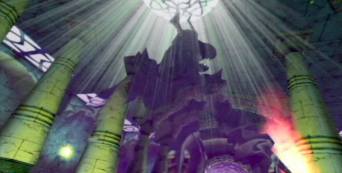
Re-use cut material
Fortunately I had a library of animations for a few species we had planned to use as baddies in the game but ultimately never got around to implementing past the animation stage. So here I had a model and a load of animations and a scene that was entirely unfathomable. So I planned a set of increasing scenes of fear that centred on all these cool ideas that never made it in. At least that way the player couldn't expect what was coming next. Yet they were all strangely familiar since they were all based on elements in the game that hadn't been cut. Feel the situation through your lead character
It was up to Fox McCloud to react to these scary characters and make the player feel like they are in danger. I didn't have time to do new animations so I just used everything he had in his library that was useful and layered on a lot of quick head turns and reaction expressions. The camera reacts
When you have very little of specific value to focus on and you're doing your best to hide the seems it's amazing what the camera can do to cover it all. By making the camera very twitchy as if it were the viewer looking around reacting to these events it pushed the sensation up a notch. Summary
The truth is you can't appreciate what affect this sequence had on the player when you are watching it out of context as a non player. Obviously the player has something at stake and the visuals in this sequence effectively served only to distract them from maintaining their composure. It was actually a very simple gameplay dynamic disguised as something more. There was some cool bits in here, but mostly nothing of any value that the player can walk away with since non of it was real... or was it. 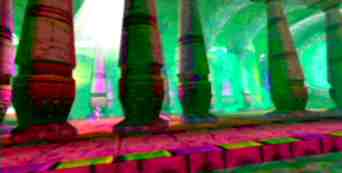 The plant
There was one moment of truth in there that served as a prelude to a later plot twist. It was virtually subliminal but part way through you look through the eyes of Andross with a very specific visual effect to signify it. The screen effect is repeated at the end of the game so that when it occurs you already have a strange association with it and you inevitably search back through your mind trying to remember where you saw it. Most likely you won't be able to recall it, which makes it that much creepier. And thus, I lay the foundations for something bigger to happen later on, without the player realising that anything had changed. |
Iconic Imagery Arwing Landings - A montage of sequences featuring Fox McCloud's Arwing space ship. Arwing Landings - A montage of sequences featuring Fox McCloud's Arwing space ship.
Highlighting your icons
I recognised early on that these sequences represented a core iconic image that highlighted where this game was going with the Starfox license, which was previously only a shoot-em-up. Since Fox McCloud had spent most of his time in a space ship, a sequence of him jumping out and landing on the ground was highly evocative of what the game was about, and symbolic of the character's development. After all he's a hero for hire underneath it all, which can take's place in all kinds of locations. Variation is the spice of life
This sequence took place in numerous locations. Initially it was the same scene, but eventually I had to make variations to fit specific nuances of the gameplay. So the camera was moved, extra characters got involved, etc...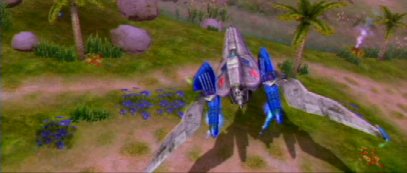 Contrasting worlds
The landing on Swapstone Hollow specifically makes a big deal of the natural, peaceful surroundings so that the arrival of a space ship has that much more of a contrasting effect. The hero shot
In one of the scenes, just as Fox lands from jumping out of his Arwing, I caught a very careful glamour shot of his face that I knew would be popular for use in the promotional material (trailers, still images, etc.). I only wish I'd used it on the original scene, then it would have been duplicated into all the others. Although it's possible that it's all the more effective for only appearing once in the game. Animating space ships
It's astonishing how many animators can't make a space ship look like it's flying. We all have a go at it at some point. The principles of flight still apply, you just have to imagine where the propulsion is coming from and how strong, in order to treat it just like a bird (tips on flight). Physics still apply! |
Dry Material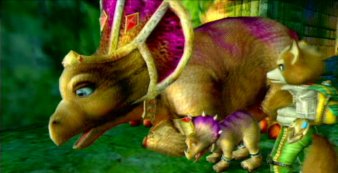  Queen Earthwalker - Fox meets Tricky's mum, but she's not in good shape. Queen Earthwalker - Fox meets Tricky's mum, but she's not in good shape.
Staging
There's a lot of very dry dialogue in this game that has to serve a function but isn't particularly entertaining in of itself. So step one towards making it more interesting was to figure out what assets I had to work with and stage the scene to take advantage of them, then keep moving things around and re-staging. That way the move to each new staging can be something interesting that keeps the visuals interesting. Of course the scenery was also pretty dull and there were dozens of scenes with these characters in this cave, so it wasn't easy! I made Fox seem bored and played heavily on the Queen's concerned face, since the best asset I had to work with was... character. |
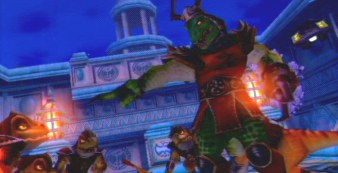 The Homage The Homage
 Scales threatens the Queen - The Cloudrunner Queen gets to see how ugly Scales can get. Scales threatens the Queen - The Cloudrunner Queen gets to see how ugly Scales can get.
Subliminal references
The script read like the scene with Darth Vader torturing the rebel soldier at the beginning of Star Wars, so that's how I played it. If you're enough of a fanatic you'll spot numerous references to that scene through the camera work and there's even a homage to Vader's expressionless observation of Han Solo being encased in carbonite from The Empire Strikes Back. |


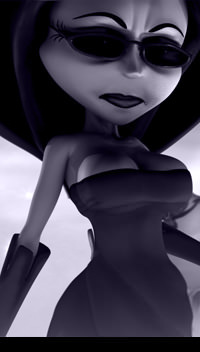
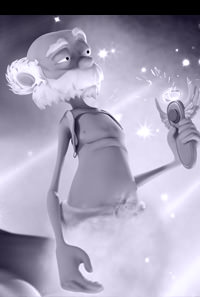
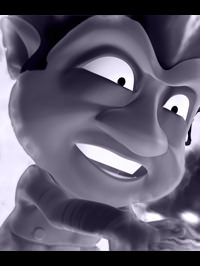
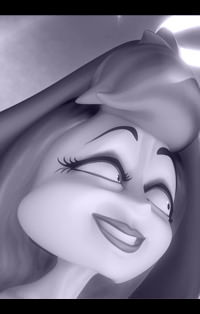
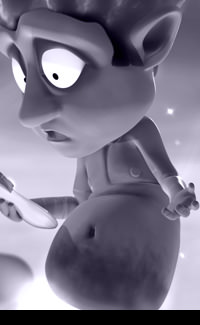
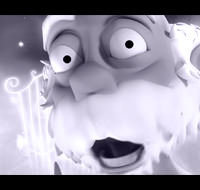
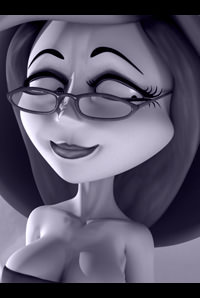
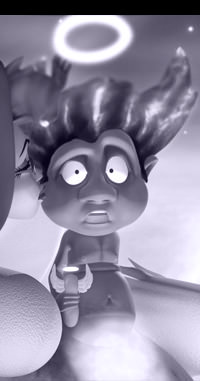










 The Homage
The Homage